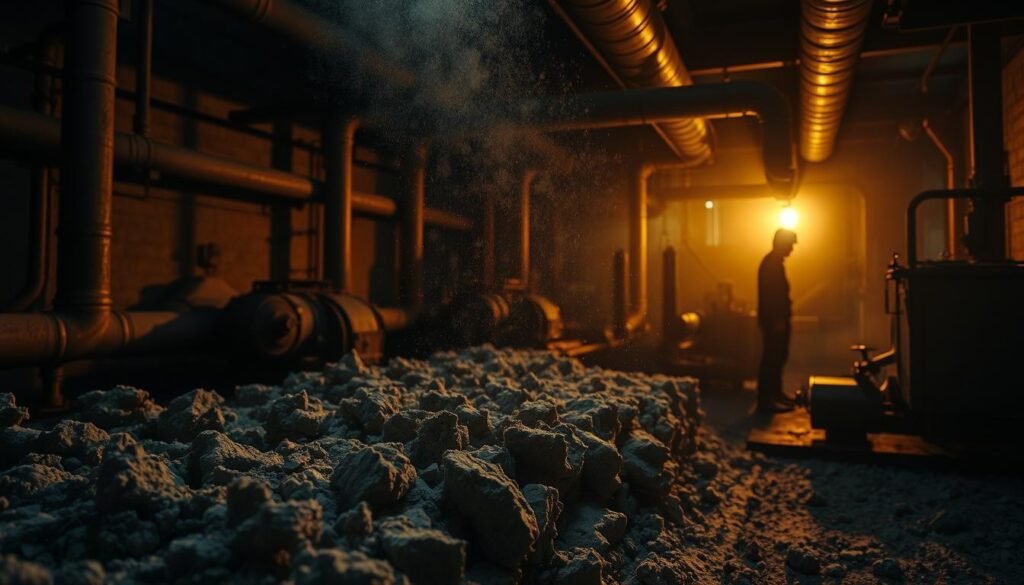Did you know about 80% of lung cancer deaths come from smoking? This fact highlights the main risk for lung cancer. Tobacco smoke has over 7,000 bad chemicals, many are known to cause cancer. Knowing this helps in lung cancer awareness and how to avoid it.
Lung cancer is a top reason people die from cancer worldwide. Understanding what leads to this disease is key to stop it. We will look into smoking, secondhand smoke, radon gas, and job-related dangers. Knowing these risks can help people avoid them and live healthier.
Key Takeaways
- 80% of lung cancer deaths are attributed to smoking.
- Secondhand smoke exposure increases lung cancer risk in non-smokers by 20% to 30%.
- Radon gas is the second leading cause of lung cancer.
- Asbestos exposure significantly raises lung cancer risk for workers.
- Outdoor air pollution contributes to approximately 5% of lung cancer deaths.
Understanding Lung Cancer
Lung cancer is a major health worry due to uncontrolled cell growth in the lungs. It’s the top cause of cancer deaths worldwide. A detailed lung cancer overview talks about its types and symptoms, which can lower life quality.
There are two main lung cancer types: NSCLC and SCLC. NSCLC is more common but not as aggressive as SCLC. SCLC spreads faster. Knowing these types of lung cancer helps choose the best treatment.
It’s key to know the lung cancer symptoms for early detection. Common symptoms are:
- Persistent cough
- Chest pain
- Difficulty breathing
- Weight loss
- Fatigue
About 90% of lung cancers are caused by smoking. Knowing the risks and symptoms can lead to fast help and better treatment results.
Chief Risk Factor for Lung Cancer
Smoking is the top risk for lung cancer, the main cause behind many cases. Studies show that about 80% to 90% of lung cancer deaths in the U.S. are due to smoking. This fact shows how critical it is to understand the risks in lung cancer.
Statistics on Lung Cancer Mortality
Lung cancer leads as the main cause of cancer deaths globally. In Canada, smoking causes about 72% of lung cancer cases. This data shows smoking’s strong link to lung cancer, with smokers 15 to 30 times more likely to get lung cancer than those who don’t smoke.
The Importance of Risk Factors
It’s key to know the role of risk factors like radon and family history in preventing lung cancer. Radon is the second main cause of lung cancer in those who don’t smoke. Other risks include being around dangerous substances like asbestos and air pollution. Knowing these can help in creating better prevention plans.
Smoking: The Leading Cause
Smoking majorly causes lung cancer and severely affects our health. A huge portion of lung cancer cases come from smoking. Studies show nearly 90% of lung cancer in men and 70 to 80% in women are due to smoking. Smoking also hurts our health in many other ways.
Impact of Cigarette Smoking on Lung Cancer
Cigarette smoke is very dangerous. It contains over 7,000 chemicals, including more than 70 carcinogens. These harmful substances greatly increase the risk of lung cancer. Smokers are about 30 times more likely to get lung cancer compared to non-smokers. In the U.S., lung cancer causes 31% of all cancer deaths in men and 26% in women.
Lung cancer survival rates are very low. Only 42% survive one year and 15% survive five years after diagnosis. Smoking’s damage can last a long time, even after quitting. Most lung cancer cases in the U.S. are in people who’ve stopped smoking, highlighting the long-term effects of tobacco.
Other Tobacco Products and Their Risks
It’s not just cigarettes; cigars and pipes are harmful too. They also increase lung cancer risk. All tobacco products are dangerous and underline the importance of quitting smoking. Understanding these dangers can push people to stop using tobacco.
| Tobacco Product | Lung Cancer Risk Level | Carcinogen Presence |
|---|---|---|
| Cigarettes | High | More than 70 known carcinogens |
| Cigars | Moderate | Contains multiple carcinogens |
| Pipes | Moderate | Presence of various cancer-causing agents |
| Smokeless Tobacco | High | Numerous harmful chemicals |
This information is crucial. It tells us how important it is to combat tobacco use. Fighting smoking and lung cancer improves public health.
Secondhand Smoke Exposure
Secondhand smoke, also known as environmental tobacco smoke, is a big health risk. It’s especially dangerous for people who don’t smoke. The smoke comes from what smokers exhale and from the burning tobacco products. This smoke has many harmful chemicals, worrying both health experts and the public.
Understanding Secondhand Smoke
Every year in the United States, secondhand smoke causes over 19,000 deaths. Nonsmokers exposed to it have a 20% to 30% higher chance of getting lung cancer. Children are at even higher risk. They can get serious breathing problems, more asthma, and even Sudden Infant Death Syndrome if their parents smoke. Research also finds that secondhand smoke sticks to surfaces, becoming “thirdhand smoke.” This increases health risks even after the smoke clears. In 2017, the loss in work productivity due to secondhand smoke was a huge $7.2 billion.
Statistics on Secondhand Smoke and Lung Cancer Risk
A study showed a clear link between secondhand smoke and lung cancer risk. It looked at 1,669 cases and 1,263 controls. The results were revealing:
| Exposure Timing | Adjusted Odds Ratio (AOR) | Demographic Group |
|---|---|---|
| Between birth and age 25 | 1.30 (1.08-1.57) | Overall population |
| After age 25 | 0.66 (0.21-1.57) | Overall population |
| Between birth and age 25 | 1.29 (0.82-2.02) | Nonsmokers |
| After age 25 | 0.87 (0.22-3.38) | Nonsmokers |
| Between birth and age 25 | 1.28 (1.04-1.58) | Current and ex-smokers |
| After age 25 | 0.66 (0.15-2.85) | Current and ex-smokers |
The most affected are those in non-smoking homes. This info highlights the need for actions to reduce secondhand smoke. Doing this protects everyone’s health and decreases lung cancer risks.

Radon Gas: An Invisible Threat
Radon gas comes from uranium decay in soil and rocks. It’s invisible and has no smell. This gas can get trapped in homes, mainly basements and places with poor air flow. The EPA states that radon is the second highest cause of lung cancer after smoking. It causes 3% to 14% of all lung cancers, depending on the country’s radon levels and smoking rates.
How Radon Forms and Accumulates
Radon seeps into buildings from the ground. Indoor radon levels can vary a lot. Sometimes, indoor levels can be over 10,000 Bq/m3. But, it’s best if indoor levels are less than 100 Bq/m3. Building design and local geology play a part in this. Smokers face a higher risk. They are 25 times more likely to get lung cancer from radon.
Knowing these risks is vital for staying healthy.
Testing for Radon in Your Home
Testing your home for radon is easy and important. You can buy low-cost test kits or hire experts for more accurate results. The EPA urges testing, especially if your home hasn’t been checked before or if known radon levels are high. Putting in a mitigation system can cut radon levels by more than half. This makes testing a big step in protecting your health.
Asbestos Exposure and Its Risks
Asbestos was once valued for its ability to resist heat. But now, it’s known for the health risks it brings. These risks are mainly seen in construction and manufacturing jobs. It’s important to understand the dangers that come with asbestos to keep people safe.
Occupational Hazards Associated with Asbestos
Workers in shipbuilding, construction, and asbestos mining often come into contact with asbestos. This contact can lead to serious health problems, like mesothelioma, a type of cancer. The risk of developing mesothelioma grows with more exposure to asbestos.
Asbestos and Its Relation to Mesothelioma
There’s a clear link between asbestos and mesothelioma. This cancer usually takes years to show up, often more than 30 years later. How asbestos exposure affects someone depends on the kind of asbestos and where the exposure happened. Even family members of exposed workers can face higher health risks. This shows how far-reaching the impact of asbestos can be.

Other Occupational Exposures
Workplaces can increase the risk of lung cancer. Harmful substances found in some jobs lead to more cases of this disease. It’s important to know which agents cause cancer to keep workers safe.
Cancer-Causing Agents in the Workplace
Some dangerous substances at work can make employees sick. These include:
- Asbestos
- Arsenic
- Beryllium
- Cadmium
- Diesel exhaust
- Nickel
- Chromium
About 10% of lung cancers worldwide come from job exposures. Many harmful substances can cause lung cancer, even in small amounts. This risk gets even higher if someone also smokes.
Protective Measures for Workers
Companies need to protect their workers. They can do this by:
- Putting in proper air systems at work.
- Giving out safety gear for different dangers.
- Checking workers’ health to find lung problems early.
- Telling employees about the dangers they face at work.
By taking these steps, workplaces can cut down on the dangers of cancer-causing substances. This makes work safer for everyone.
Air Pollution as a Risk Factor
Air pollution is a big health problem in cities, especially for lung cancer. As more people live in cities, the air gets worse. This is because of car fumes, factories, and other polluters. Although smoking is the main reason for lung cancer, air pollution causes about 1% to 2% of these deaths in the US. The link between air quality and lung health is getting clearer as studies continue.
The Impact of Urban Air Quality
Bad air is especially harmful to kids, older people, and those already sick. Tiny particles in the air can make lung cancer worse. A study looked at how air pollution impacts lung cancer risk. It found that factors like where you live and your genes can make things worse. People in polluted cities need to know about these health risks.
Long-Term Effects of Air Pollution on Lung Health
Being around dirty air for a long time can cause lasting lung problems. These issues can lead to lung cancer. Studies show that COPD is closely linked to lung cancer in smokers, apart from smoking’s other risks. Air pollution harms the lungs, and genes play a role in how bad it can get. This highlights the urgent need for clean air actions to protect our health.

Family History of Lung Cancer
Having family members with lung cancer can raise your own risk of getting the disease. Studies show that if your close relatives have lung cancer, your risk goes up. This is especially true for people with first-degree relatives who are sick.
Genetics and Lung Cancer Risk
Genes play a big part in lung cancer risk from family history. If any family member has had it, your chance to get lung cancer increases (OR = 1.57). The risk jumps higher if a sibling has had it (OR = 1.82). Genes, along with common family exposure to things like smoking or radon gas, make some people more likely to get lung cancer.
Shared Environmental Exposures
Living or being in the same place as family can affect lung cancer risk too. Families share air and space, so they get exposed to the same harmful stuff. Having a family history of chronic bronchitis ups lung cancer risk (OR = 1.49). But, a family history of pneumonia might lower the risk (OR = 0.73). These numbers show how our genes and surroundings work together in complex ways.
Knowing about risks passed through families helps us watch out for and prevent lung cancer better. Understanding both genetic and environmental factors is key. This knowledge leads to better care and ways to target the disease.
| Relation | Odds Ratio (OR) |
|---|---|
| Any Family Member | 1.57 |
| Father | 1.41 |
| Mother | 2.14 |
| Sibling | 1.82 |
| Chronic Bronchitis | 1.49 |
| Pneumonia | 0.73 |
Chronic Lung Disease as a Risk Factor
Chronic lung diseases greatly affect health and up the risk for serious conditions like lung cancer. It’s key to understand the lung cancer correlation with these diseases for patients and doctors. COPD and other long-term lung problems can make cancer more likely because of constant inflammation and damage.
The Link Between Lung Diseases and Cancer Development
Studies show a scary link between chronic lung disease and higher cancer risk. In areas with 7.8% to 19.7% COPD cases, it’s a big cause of death. COPD doesn’t just increase death rates but also raises the risk of pneumonia and heart diseases. By 2020, it was expected to be the third biggest killer worldwide.
Research found that 33% of lung cancer deaths were in non-smokers with minor breathing issues. Over 10 years, lung cancer was 8.8% likely in people with these airflow problems, but only 2.0% in healthy individuals. Notably, major drops in a certain lung function test (FEV1) were closely linked to dying from lung cancer.
Gender affects these risks differently. Women with even small drops in FEV1 had 2.6 times higher lung cancer risk, while men had a 1.3 times increase. This shows the need for special health care and checks for people with chronic lung disease.
Specific lung issues, like chronic bronchitis and emphysema, also make lung cancer more likely. The risk rates for chronic bronchitis and emphysema were 1.33 and 1.50, respectively. This underlines how crucial it is to tackle these conditions early.
The Role of Dietary Supplements
The concern about dietary supplements and lung cancer risk is growing among healthcare experts. The nutraceutical industry has boomed, offering over 90,000 dietary supplements. This is up from just 4,000 in 1994. This boom has increased focus on their impact on cancer prevention.
Beta-Carotene and Lung Cancer Risk
Beta-carotene, which turns into vitamin A, was once thought to help protect against some cancers. But newer research has brought caution. Studies now show that beta-carotene supplements could raise lung cancer risk, especially in smokers.
Beta-carotene and vitamin A supplements have been specifically linked to more lung cancer cases and deaths. Using vitamin B6 and B12 for a long time might also increase lung cancer risk. These findings stress the need for careful use of dietary supplements in cancer prevention. More in-depth and quality research is needed.
| Supplement | Risk of Lung Cancer (Hazard Ratio) | Notes |
|---|---|---|
| Beta-Carotene | 1.36 (95% CI: 1.07-1.73) | Increased incident rates |
| Vitamin A | 1.59 (95% CI: 1.13-2.23) | Higher mortality rates |
| Vitamin B6 | 1.82 (95% CI: 1.25-2.65) | Risk observed after 10 years |
| Vitamin B12 | 1.98 (95% CI: 1.32-2.97) | Potential risk factor |
Conclusion
Knowing the main risk factors for lung cancer is key to preventing it. Smoking is the top cause, responsible for about 85% of cases. Being around secondhand smoke or exposed to radon gas, asbestos, and job-related dangers also increases risks. Plus, air pollution plays a big role in lung cancer, showing why awareness is important.
In 2018, the world saw an estimated 2.1 million new cases of lung cancer. This highlights the need for action to prevent the disease. People with lung disease in their family or who have chronic lung issues are at higher risk. To lower the risk, it’s smart to eat lots of veggies and fruits and avoid bad substances.
To keep lungs healthy, understanding lung cancer risks is essential. Getting regular health checks and thinking about the environment helps fight this tough disease. By sharing info on what increases risk, we help everyone make choices that lead to healthier lives. This can lower the number of lung cancer cases.